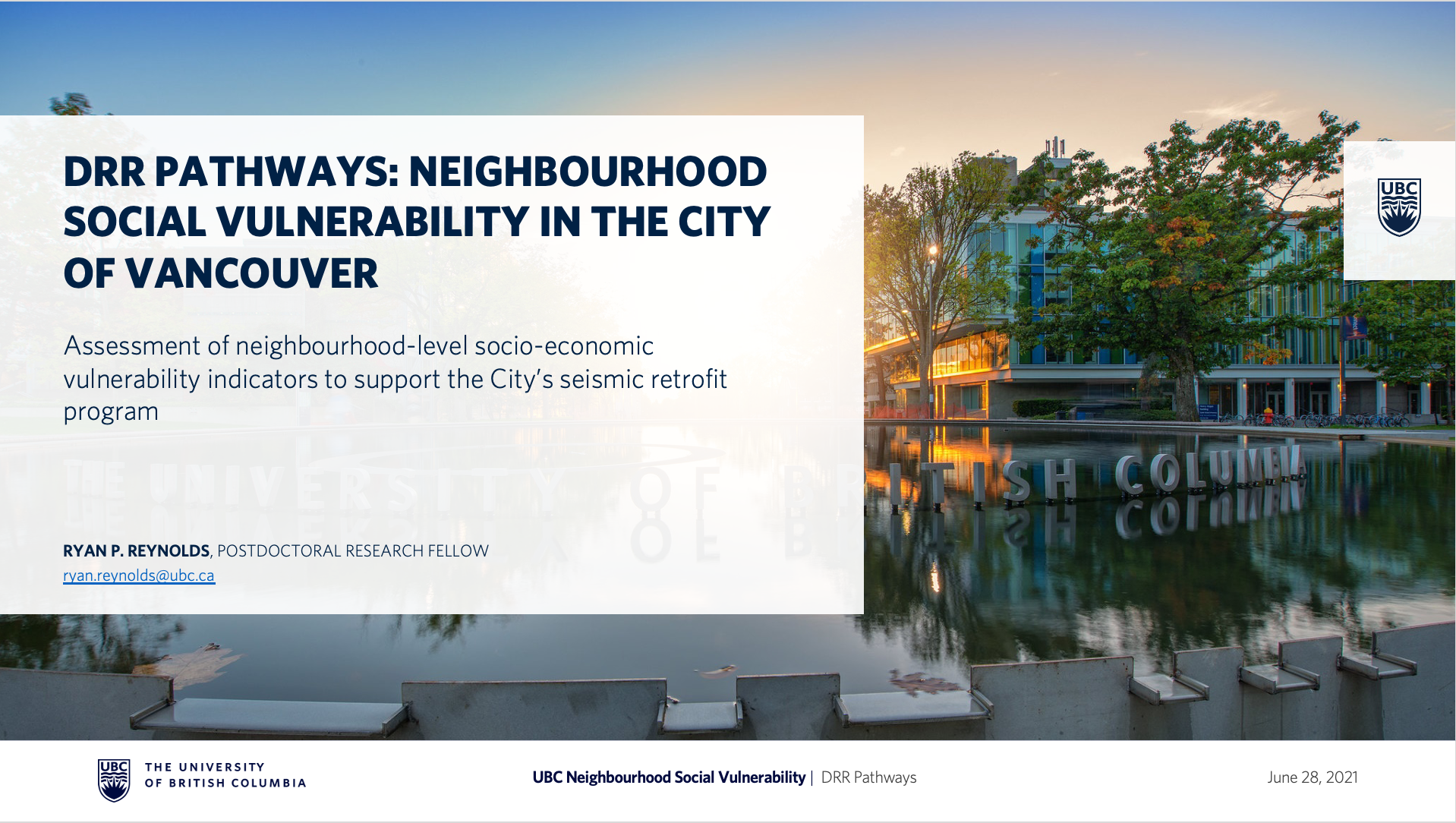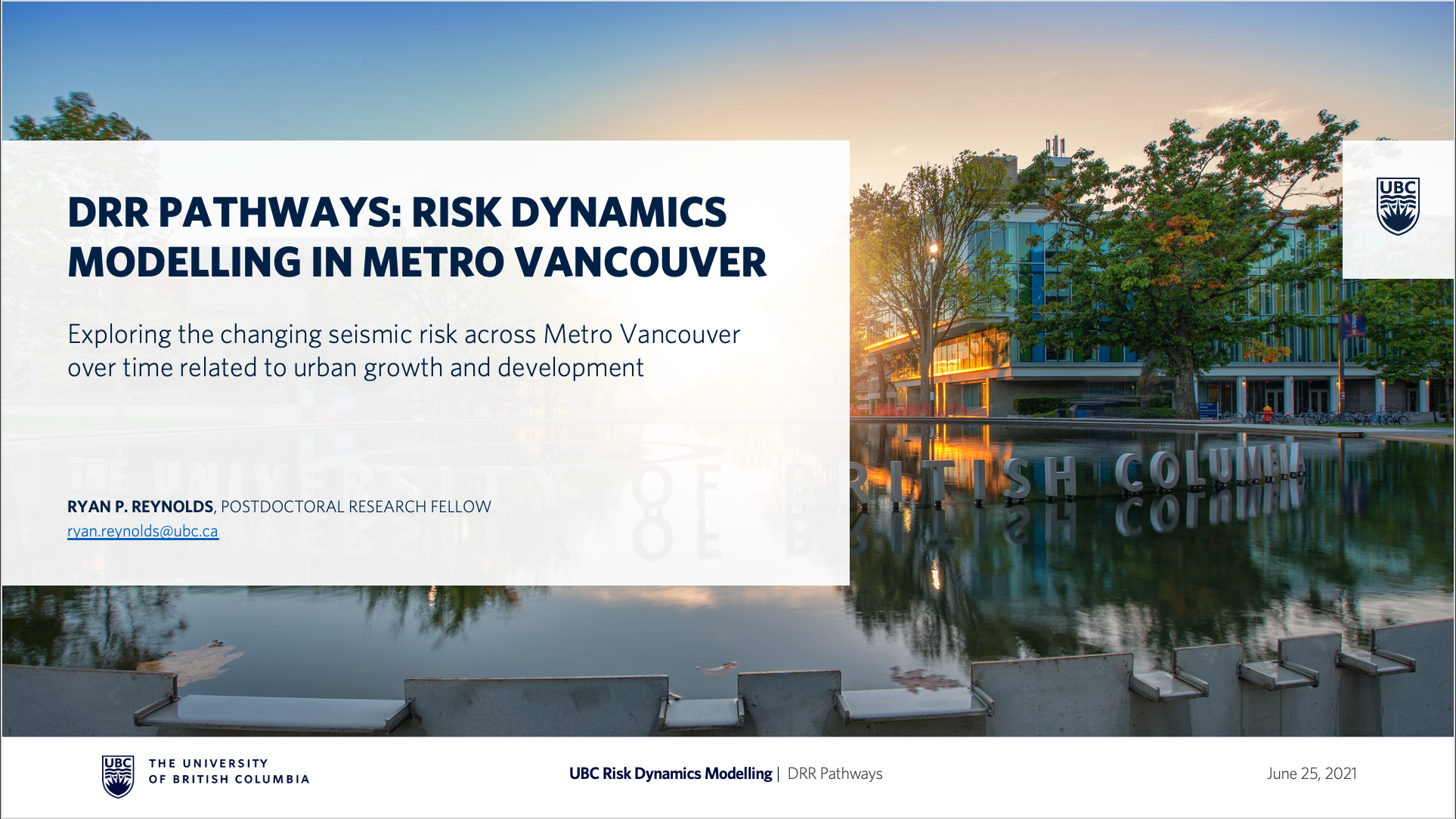
Disaster Risk Reduction Pathways
Developing Pathways to More Hazard-Resilient Communities
Photo Credit: Colin Knowles
Resilience Pathways in BC
“This first edition of the Resilience Pathways Report (2022) seeks to better understand disaster and climate risk interactions with socioeconomic development in BC and to identify gaps, challenges, and recommendations for the way forward.
“The Resilience Pathways Report is aligned with the Sendai Framework for Disaster Risk Reduction 2015–2030’s systemic approach to risk management, with emphasis on the whole of society and collaborations among all actors. More than 70 experts from a wide range of institutions and disciplines have contributed. The articles herein cover a diverse set of topics, organized to allow for comparing and digesting information across hazards, sectors, and risk management issues, and include both findings and recommendations.”
Our Contributions
Our team within the School of Community and Regional Planning at UBC contributed three components to the Disaster Risk Reduction (DRR) Pathways project exploring how potential future disasters will likely affect our communities today and into the future.
Working with our partners at Natural Resources Canada, the Canadian Safety and Security Program, Metro Vancouver, the City of Vancouver, the University of Victoria, and Sage on Earth Consulting, our contributions seek to use cutting-edge hazard risk information and research to inform local, regional, and national planning efforts. Our goal in bringing together government agencies, non-governmental organizations, and academia was to establish shared pathways toward more hazard-resilient communities in BC and across Canada.
Below are quick summaries for each of our three projects, along with links to reports and videos where you can learn more:
Neighbourhood Social Vulnerability in Vancouver, BC
We know that the physical damage and social impacts of disaster are not distributed evenly across space, through time, or within affected populations. Often, the groups with the least capacity to respond experience the most substantial impacts and, thus, experience the slowest recoveries.
Working iteratively with our partners, we identified a set of 14 socioeconomic vulnerability indicators across three themes tied to specific policy objectives. This work allows us to identify those neighbourhoods within the city that are more susceptible to the effects of a disaster due to their physical, social, or economic traits.
By tying this information to recent earthquake impact assessments generated by Natural Resources Canada, it becomes possible to identify neighbourhoods where early interventions could help reduce impacts on residents and speed up post-disaster recovery.
Risk Dynamics in Metro Vancouver: How neighbourhood change affects future risk
Planning for future risk faces a challenge in understanding our neighbourhoods and communities are likely to change over time. Risk dynamics pertains to how the potential for disaster losses in an urban area may change over decadal timeframes. Disaster risk will transform over time in relation to factors such as population growth, land use changes, new construction, and building code improvements. These may cause the overall risk to increase or decrease, and the locations of “hotspots” may shift over time.
Using growth projections from Metro Vancouver and earthquake impact scenarios from Natural Resources Canada, our team used information about how neighbourhoods change over time to estimate how earthquake risk will likely change in Metro Vancouver in 2035 and 2050.
Anticipating future risk trends and patterns can help to identify and better characterize the effectiveness of different risk reduction strategies.
Indicators of Neighbourhood Resilience, Recoverability, and Recovery
The disaster recovery phase of the hazards disaster management cycle occurs following the immediate impacts and response following a disaster event. This phase focuses on restoring a community's built, social, economic, and natural environments post-disaster.
"Recoverability" refers to the projected capacity of a neighbourhood to return to some acceptable level of functionality, estimated before a disaster event. More resilient communities will generally be better placed for a quick and successful recovery, while more vulnerable communities often experience slower, less successful recoveries.
We identified a set of eleven disaster recovery indicators at the census tract level focused on access to critical goods and services, business stability and sustainability, and socioeconomic factors impacting resident recovery capacity for the City of Vancouver.
Project Involvement
I was a Postdoctoral Research Fellow with the School of Community and Regional Planning team contributing to this project from its inception in 2019 through to its completion in June 2021. We were initially committed to just exploring neighbourhood vulnerability and risk dynamics, but later expanded to include the neighbourhood recovery and recoverability.
During my time I contributed to these projects in the following ways:
Worked with our partners to develop the social vulnerability indicators used for the neighbourhood social vulnerability assessments;
Worked with our team to develop neighbourhood-scale indicators for recovery and recoverability;
Worked with our team to use historic measures of neighbourhood archetype change and growth projections to estimate how earthquake scenarios may play out based on projected neighbourhood changes;
GIS models to incorporate and process source data into the necessary geospatial products for each of these projects;
Graphic design of report illustrations, and charts;
Creation of all project maps; and
Writing and/or editing the technical and final reports for all three projects.
Related Presentations
Ryan discusses the work behind UBC’s social vulnerability contribution to the DRR Pathways project along with our key findings at the report launch party.
Video Presentation (8:00, MP4)
Slidedeck (PowerPoint)
Ryan talks about risk dynamics, our methodology for estimating future risk, and our initial findings for Metro Vancouver at the report launch party.
Video Presentation (8:43, MP4)
Slidedeck (PowerPoint)
Ryan describes the work we completed on neighbourhood recover and demonstrates how we worked with our partners to show how power, water, and wastewater are critical to hospital service at the neighbourhood scale.
Video Presentation (9:03, MP4)
Slidedeck (PowerPoint)



